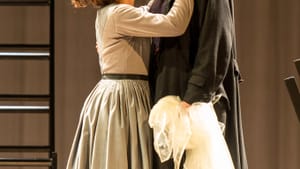Stay in the Loop
BSR publishes on a weekly schedule, with an email newsletter every Wednesday and Thursday morning. There’s no paywall, and subscribing is always free.
Taking Thornfield home
National Theatre Live presents a free stream of Charlotte Brontë’s ‘Jane Eyre’

Like Greta Gerwig’s 2019 film adaptation of Little Women, the National Theatre’s Jane Eyre reworks a classic 19th-century novel for the 21st century. Both books were written by a woman (Louisa May Alcott and Charlotte Brontë, respectively), feature strong-yet-underdog female leads, and emphasize women’s potential and autonomy. For these reasons and more, generations of readers—me included—have loved, admired, and aspired to emulate Alcott’s Jo and Brontë’s Jane.
A pivotal force
Reimagining a beloved literary classic poses particular creative challenges, like translating a book to stage and screen, making a product of the past legible and digestible, and balancing the expectations of fans with the needs of newcomers to the story. The National Theatre’s Jane Eyre handily accomplishes this through innovative staging, creative storytelling, and strong performances by the featured actors. Together, these elements generate a Jane Eyre for our time that feels fresh and relevant to the quarantined viewer.
First staged by the Bristol Old Vic in 2015, this version of Jane Eyre transferred to the National Theatre in the same year, with a revival in 2017. Now viewers everywhere can see it on YouTube for a limited time, as the National Theatre recognizes that “theatre and the arts are a pivotal force for our community in turbulent times.” Indeed, the play seemed remarkably resonant as I watched on my laptop in my little apartment in this newly quiet city of masked shoppers. This Jane Eyre seizes upon perfect shelter-in-place themes: the universal need to love and be loved, to connect with other humans, to feel free even when faced with limited options.
Wide open
As the orphan Jane’s story begins, the camera pans over the set, a series of ramps, platforms, and ladders of wood and metal that suggest a deconstructed house. Like that house, young Jane is wide open, refusing to hide her thoughts and feelings for the sake of expectation and propriety.
Aunt Reed, her guardian, regards Jane as a burden, and John, her cousin, sees her as less than human. But she is human, and all she wants is love, acceptance, and a fair chance in life. As Jane, Madeleine Worral masterfully captures a potent mix of emotions. Embraced by the kind maid Bessie, Worral’s affection-starved Jane turns her face to the audience, registering a feeling of overwhelm that borders on pain.
Fresh and interesting
The ensemble casting highlights the universal quality of Jane’s quest as well as the human capacity for being our best and our worst. Simone Saunders plays Jane’s mother before transforming first into Bessie, then into Jane’s romantic rival Blanche Ingram. Similarly, Laura Elphinstone appears as Jane’s school friend Helen and her pupil Adele, then as St. John Rivers, the suitor who cannot truly see or appreciate Jane. And Felix Hays portrays both cousin John and Thornfield’s Edward Rochester. Meanwhile, Craig Edwards brings comic relief through his performance of Pilot the dog, barking and beating his rope tail, yet he also portrays Jane’s antagonists Reverend Brocklehurst and Richard Mason. The fact that these roles transcend the races and genders of the actors feels especially contemporary.

Other aspects of the production keep the play fresh and interesting, even at nearly three hours long. (I watched the performance in segments—streaming at home has its upsides.) These include musical interludes with a live band, evocative lighting that creates the illusion of different settings as well as the moods of those places, and artfully staged movement sequences. The most memorable of these are various stagecoach rides conveyed by actors jogging in place as voices called out the names of stops in an acapella near-rap, and a series of synchronized gestures depicting Jane’s spartan, repetitive life at Lowood Institution—scrubbing, praying, coughing—under the domineering Reverend Brocklehurst.
Hoping like Jane
At Lowood, Jane longs for more, which the play captures in Jane’s fantasy of throwing open a window and feeling air—not a gentle breeze, but a driving wind—in her face. She meets her match in Rochester, a man of similar passions who values his mirror in Jane.
The play’s ending offers healing to the powerless, unloved orphan at the heart of the story as well as the isolated viewer. Like Jane, we cling to the hope that someday we, too, will have our chance to go out into the world to seek, and to find, our heart’s desire.
What, When, Where
England’s National Theatre presents Jane Eyre, a co-production with Bristol Old Vic, devised by the cast and based on the novel by Charlotte Brontë, directed by Sally Cookson. Streaming free on YouTube through April 16, 2020, as part of the National Theatre at Home series. Watch it here.
The series continues with Bryony Lavery’s adaptation of Robert Louis Stevenson’s Treasure Island, beginning April 16, and Shakespeare’s Twelfth Night on April 23.
Sign up for our newsletter
All of the week's new articles, all in one place. Sign up for the free weekly BSR newsletters, and don't miss a conversation.

 Melissa Strong
Melissa Strong